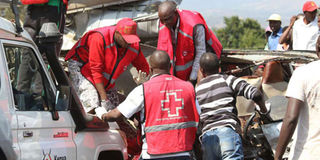Let us stand up for aid workers

Kenya Red Cross workers conduct a rescue operation at Ng'onyi, Meru County, on August 12, 2017 where there was a road crash. Aid workers must be celebrated. PHOTO | PHOEBE OKALL | NATION MEDIA GROUP
What you need to know:
- Let us raise our voices and urge world leaders to do everything in their power to protect civilians in conflict.
- This loss of immediate family members has meant that the traditional family unit is constantly being revised.
Today is Word Humanitarian Day. It is a day we pay tribute to health and aid workers who risk their lives in compassionate with others.
This year, humanitarian partners come together to reaffirm support for civilians caught in conflict on #NotATarget.
Let us raise our voices and urge world leaders to do everything in their power to protect civilians in conflict, and safeguard the lives of those caught up in natural and man-made crises.
CRISES
The world needs to focus on Yemen, Syrian, South Sudan, Somalia, Iraq, Afghanistan, Sierra Leone and other tragedies.
As we acknowledge the selfless aid workers who put their lives in danger, it is worth appreciating a number of heroes whose efforts often go unrecognised.
In every crisis, there is the unfortunate loss of life and displacement of people.
Family members are separated, some never to meet again.
FAMILY
Children lose parents and someone has to take up the mantle of principal guardian or caretaker in the midst of the chaos.
Inevitably, the gap left by deceased or displaced parents is filled by siblings or extended family members.
This loss of immediate family members has meant that the traditional family unit is constantly being revised.
A father, mother or grandmother begins playing the role of the mother.
Those who have taken part in aid operations can attest to the fact that the family unit is a blessing.
CORONER
During a war, a close family member may be killed in a crossfire or an explosion.
The coroner has the duty of identifying the victim. To do this daily is admirable.
The coroner brings comfort to the family when he or she identifies the dead.
With every crisis you watch on TV or read in newspapers and the internet, there is a photographer or journalist involved.
Imagine a situation where your work entails dodging bullets or the fear of kidnapping, being caught up in the vicinity of chemical weapons or being used as a human shield.
REPORTERS
These men and women are on the frontline of danger.
Journalists face death and injury just to keep us informed. Without their persistence and bravery, we would be living in a bubble.
Journalists are also traumatised psychologically because of what they see.
While what we see is shocking, it should be noted that the images have been edited.
A journalist encounters the problems live. That is why we need to be cautious when posting photos or videos on social media.
IMAGES
Kenyans have formed a habit of posting distressing images on social media in the event of a tragedy.
The Naivasha road accident where 40 people lost their lives comes to mind.
Sadly, social media platforms operate in a laissez faire manner and will not warn you about their images.
Nevertheless, even in the worst case scenario, the mainstream media is responsible enough to spare the audience of such sights.
CASUALTIES
In this digital era where anyone can become a “journalist”, it is important that we take a step back and assess the impact of what we are about to share.
Families and friends of the dead or badly injured, rather than the message, should be the guiding principle.
Nobody wants to be made to go through a moment he would want to quickly forget.
Happy World Humanitarian Day; #Notatarget.





